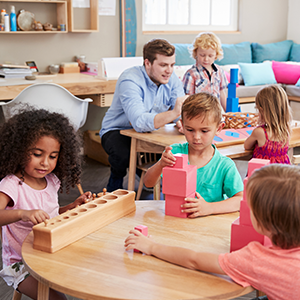Young children aren’t usually known for intense concentration. To the
contrary, kids are expected to bounce from one activity to another with the
attention span of a gnat. That’s why parents are surprised by what they see
when they tour Eton Montessori School in Bellevue, Washington: Children as
young as three happily engaged in independent, focused work for long
stretches.
Parents are just as surprised by what they don’t see – no lecturing
teachers prodding reluctant kids to complete assigned work. “Our children
are self-motivated. Our teachers don’t stand over them, telling them to be
quiet and get back to work,” says Patricia Feltin, Ph.D., who founded Eton
School in 1978. This ability to focus at a young age is a hallmark of
Montessori education, but it’s revolutionary to parents who haven’t seen a
Montessori classroom in action.
Montessori learning is hardly novel – Maria Montessori’s first school
opened its doors in 1907. But a trend toward mindfulness in education is
sparking new interest in this century-old style of education, and new
science is showing how this type of learning benefits today’s young minds.
Mastering Mindfulness
Over the past decade, organizations like Mindfulness in Education Network,
Association for Mindfulness in Education, and Mindful Schools have sprung
up, training teachers, hosting conferences and producing research aimed at
helping children become more focused, motivated and intentional in the
classroom.
Just what is mindfulness, exactly, and why does it matter?
MindfulSchools.org paints mindfulness as a deep, in-the-moment focus,
characterized by self-awareness and internal motivation. In a world filled
with chaotic distraction, advocates of mindfulness say it can be a salve
for the conflict, impulsiveness and stress plaguing modern students and
schools.
Steven J. Hughes, Ph.D., a pediatric neuropsychologist specializing in
attention, concentration, planning and organizing – a set of traits known
as executive functions – defines mindfulness as “sustained positive
engagement.” Other scientists refer to a “flow” state of prolonged,
energized work that produces both calm satisfaction and profound joy in
learning.
Whole Body, Whole Mind
Maria Montessori didn’t coin the term “mindfulness,” but she was an early
advocate for sustained focus and internal motivation. Her methods
deliberately encourage intense concentration as the best context for early
learning.
‘Montessori’s approach to motor development actually stimulates cognitive
development and deep concentration,” says Hughes. When children begin
Montessori education at three or four, they work on motor-skills activities
like sweeping, polishing silverware and pouring. These aptly-named
“Practical Life” activities prepare kids for greater independence and
self-reliance in daily tasks, and also help them develop higher cognitive
functions essential to concentration and attention.
“Montessori tasks like wiping a table or washing dishes develop not only
fine motor control, but they also activate areas of the pre-frontal cortex
essential to executive function, which paves the way for greater
concentration and focus,” he says. “Dr. Montessori wrote about the close
relationship between cognitive development and motor development in 1949.
Fifty years later, scientists made the same connection. This whole-body
approach is part of the reason numerous studies show that
Montessori-educated children have an academic edge over children educated
in traditional classrooms,” he says.
Happy Work: Environment, Schedule and Shared Focus
One way Montessori promotes focus is through a carefully prepared
environment, a key component of Montessori learning. In Montessori
classrooms, specially designed materials – from child-size brooms to lacing
cards to counting beads – are prepared to be aesthetically appealing and
accessible for young children; simplicity, beauty and order are paramount.
“Montessori environments are designed to be attractive and appealing, and
to allow children to make a choice. Children get to look around and choose
what they want to do,” says Feltin.
“This important act of choosing one’s own activity promotes sustained
engagement,” says Dee Hirsch, president of the Pacific Northwest Montessori
Association and director of Discovery Montessori School in Seattle.
Montessori-taught children choose their own work from a palette of
developmentally appropriate options that grow progressively more complex
and challenging.
Montessori schools incorporate concrete learning goals into a child’s
educational plan, and children are free to choose when and how to complete
their work within a specified time frame. “That act of choosing is what
allows a child to make a wholehearted commitment to their work. It’s what
makes Montessori education child-centered,” says Hirsch.
When children are motivated by their own interests, deep concentration is a
natural result. Hirsch says, “Kids are choosing what they want to focus
on.”
During a 90-minute work period, children can take their work through its
beginning, middle and end. Working through this natural sequence promotes
competence and mastery; children can repeat the activity as many times as
they want without being told to hurry up and move on to something else.
Though the terms focus and concentration conjure up images of a child
working alone, mindfulness is not always a solo pursuit. Montessori-style
learning helps kids learn the fine art of shared concentration by
encouraging them to engage in tasks with a classmate or two – a critical
skill in the age of teamwork.
Mindful Together
How does this Montessori-style mindfulness benefit children? Greater
confidence, longer attention spans and natural self-motivation are a few of
the rich rewards, according to Feltin. “What’s so wonderful is the
confidence they gain. Their attention spans are lengthened. They’re going
to meet their academic goals, but they’ll do it more naturally because
their motivation comes from within.”
“But mindfulness isn’t something teachers can achieve for students. Like
every other outcome in Montessori learning, students have to work toward it
themselves. They’re not going to reach that state of mindfulness unless
they get there themselves,” says Hirsch. “We can’t take them there, but we
can go there with them.”


